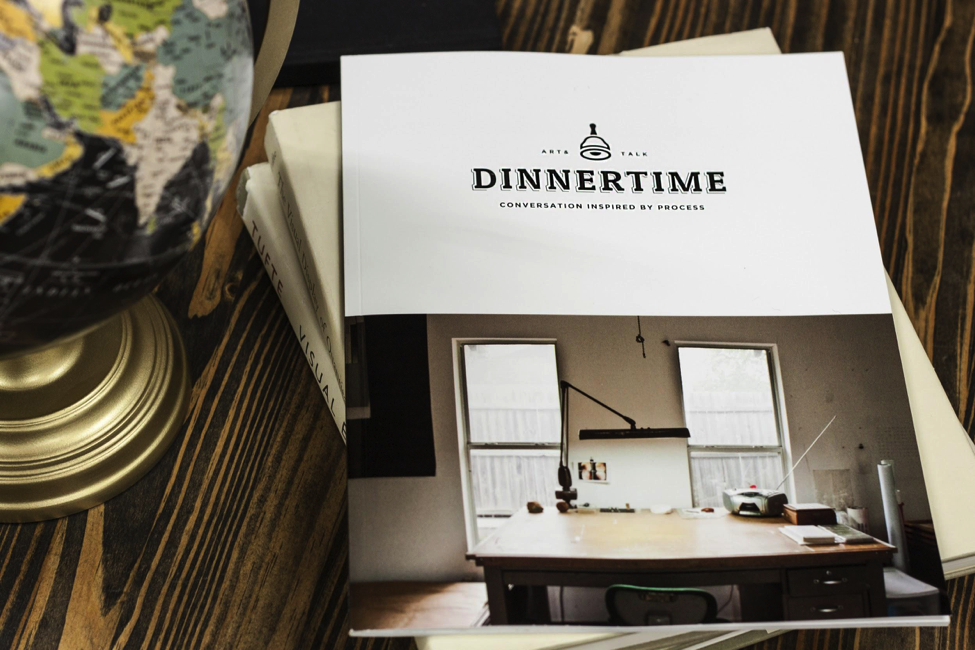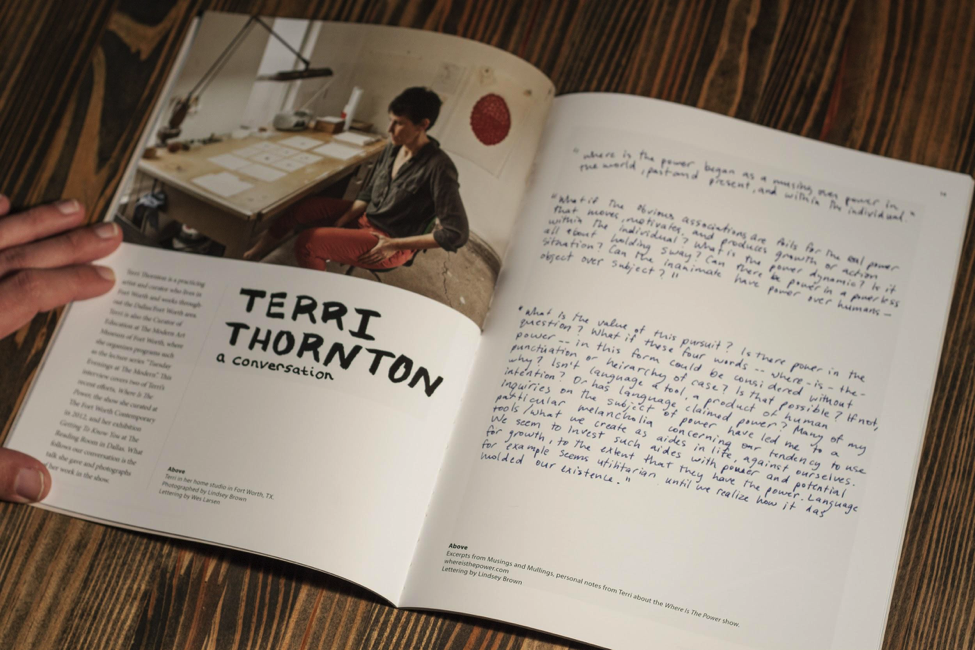This week’s contributing bloggers are Lindsey Larsen and Wes Larsen. Lindsey is an artist, writer, curator, and self-publisher currently based in Fort Worth, Texas. Wes is an independent designer focused on meaningful collaborations with institutions of art, craft, culture, and social practice. He is also a partner at the Fort Worth based digital design agency Tocco.
Together they are the creators of Dinnertime Magazine, an experimental publication project featuring process based content and collaborative conversations with artists. They recently sat down to discuss the project from its start. In the context of rethinking the publication’s identity, they examine its role in their respective creative practices, how it fits into the existing world of experimental publication, and what that means for the project moving forward.
We — that is, Lindsey (Editor-In-Chief) and Wes (Creative Director) — have varied backgrounds in photography, printmaking, and graphic design. Dinnertime was conceived in the context of the zine culture we came up in, and was heavily influenced by the community-based, collaborative network of fellow printmakers and artists. The tangibility of the printed publication is directly connected to the democratic, non-precious nature of printmaking. The counterculture’s approach to a means of production that is accessible and non-prohibitive are important aspects of what we have adopted from that background. In the current climate of crowd-sourced publications like The Great Discontent and digital publications like East of Borneo, we have opted to maintain more control over the finished product by seeking out tools that are cost-efficient and self-driven, without being reliant on a base of readers or other contributors.
We have looked to magazines like Pastelegram, BOMB, and Cabinet, which function not only as art publications, but also as journalistic outlets for developing context around contemporary issues. These publications have set a standard for flexible, varied content that uses art as a jumping-off point for larger conversations. A long-term goal of the project is to follow the likes of Draw Down Books, People of Print, Endless Editions, and many others – to provide a platform for publishing the thoughts and ideas of our contemporaries. Not quite a zine, not quite an artist book, magazine, or journal, Dinnertime is something that exists in between, borrowing from each of these categories in different ways.
Wes: As I’ve been working on this new identity for Dinnertime, I’ve been thinking a lot about how I had developed a logo and a visual system that would act as a conceptual mission statement for the first two issues. They took a lot of cues from traditional publications in terms of typography, readability, and structure. We had three artist features and a critical thinking exercise and we had to make it work within that structure. What’s driving this new identity system is this realization that it needs to be more flexible and adaptive than that and act more like a supportive element to the content instead of being this sort of introductory brand element that you kind of forget about once you flip past the first page.
Lindsey: The system we initially set up definitely served its purpose. When we started this project, we set out to make a magazine, almost for a magazine’s sake. It seemed like the right thing to do at the time.
W: So why do you think it was so important in the beginning to have it be so rigid?
L: The structure of it really gave me a reason, or more like an excuse to do it. I knew I wanted to talk to other artists about their practice and their research and I understood that activity as making a magazine… I certainly didn’t have an understanding of how it could be more than that. My definition of publication has expanded since then. I was thinking too much about the audience regularly needing or expecting something. I thought I needed to stay in front of their expectations a little bit, but the longer we’ve been working on this, the more my understanding of what we’re actually doing has shifted.
W: Early on, people close to us would ask, “What is the audience supposed to get from this, how can you be sure that this content is even, in some cases, digestible?” They had a point; some of the content in the first two issues was very obscured and almost abstract. The magazine functioned more like an art book than a publication or magazine about art. That’s really when I started to think of the magazine as artistic practice, or potentially as art itself versus just the output of an artist’s practice, whether that’s our work or the work of the artists being featured. Then you can kind of accept the fact that as an artwork, it doesn’t really owe you anything as far as digestibility, legibility, or readability goes. All it owes to you is to be authentic and if you find value in that authenticity then that’s all there is, you know? That’s what you get from it, that it’s authentic and it’s interesting, hopefully.
L: Yeah, which is how I see it now, too. I knew that the activity of making Dinnertime was really important to me, but I thought that I had to frame it in a certain way in order to keep doing it. The first two issues we tried to make these very different practices fit into this rigid system, but the more we’ve done it, we’ve realized that it’s not really about fitting those things into the package of a magazine. It’s the activity of having conversations, visiting studios, and building relationships that really matters.
Stay tuned for Part II of this conversation, which will be published on VoCA Blog later this spring.



[…] Together they are the creators of Dinnertime Magazine, an experimental publication project featuring process based content and collaborative conversations with artists. They recently sat down to discuss the project from its start. In the context of rethinking the publication’s identity, they examine its role in their respective creative practices, how it fits into the existing world of experimental publication, and what that means for the project moving forward. (This is the second chapter of their three-part conversation; if you missed Part I, click HERE.) […]
[…] Together they are the creators of Dinnertime Magazine, an experimental publication project featuring process based content and collaborative conversations with artists. They recently sat down to discuss the project from its start. In the context of rethinking the publication’s identity, they examine its role in their respective creative practices, how it fits into the existing world of experimental publication, and what that means for the project moving forward. (This is the third chapter of their three-part conversation; if you missed Part I or II, click HERE.) […]